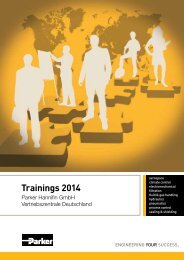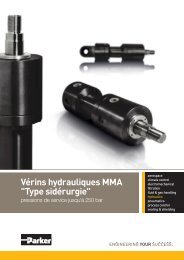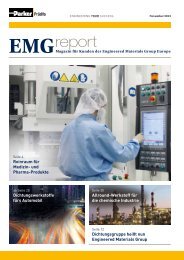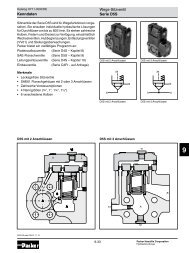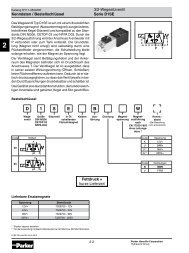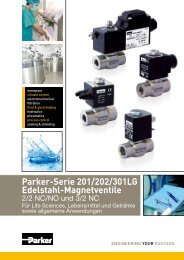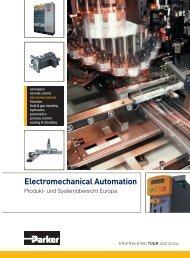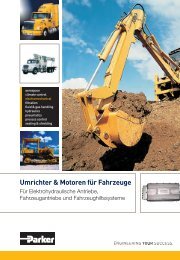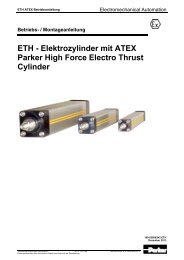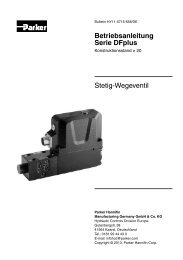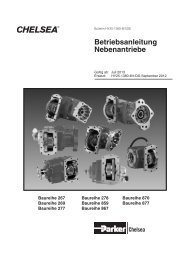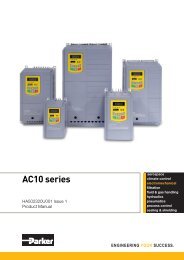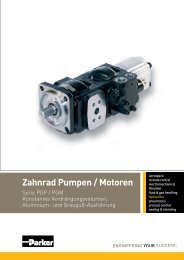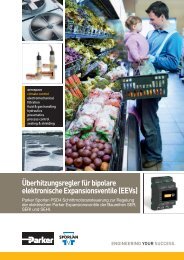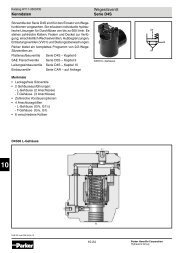L50 Injection Lubricator - Parker
L50 Injection Lubricator - Parker
L50 Injection Lubricator - Parker
You also want an ePaper? Increase the reach of your titles
YUMPU automatically turns print PDFs into web optimized ePapers that Google loves.
Installation:<br />
General Installation Oil Supply & Reservoir Options<br />
It is recommended that the <strong>L50</strong> be installed immediately<br />
downstream of a particulate/moisture removal air line<br />
filter, and a pressure regulator, in order to insure long<br />
life and trouble-free performance. In most cases, it is<br />
desirable to use the 1/8" diameter nylon capillary tubing<br />
to deliver oil down the inside of the air supply pipe, or<br />
hose, to the point of use. In these cases, thread the<br />
capillary tubing into the pipe prior to assembling to the<br />
outlet port of the lubricator. If the capillary tubing is<br />
inserted into standard pipe, cut the capillary tubing so<br />
that it is approximately 6" from the inlet port of the air<br />
device. If the tube is inserted into a flexible hose, cut<br />
the capillary approximately 10% shorter than the hose<br />
to allow for diameter expansion and resultant shortening<br />
of air hose length. After the capillary tube is installed,<br />
connect the lubricator inlet port to the air supply line,<br />
connect the capillary tube to the lubricator barbed oil<br />
outlet, and then connect downstream air piping.<br />
Air Supply<br />
Oil From Reservoir<br />
Oil Through<br />
Capillary to<br />
Tool<br />
Air To Tool<br />
Integral Reservoir (“R” option)<br />
The <strong>L50</strong> is available with an integral 10 oz. reservoir.<br />
The unit must be oriented so that the reservoir remains<br />
in the vertical position, with the vent and fill plugs on<br />
the top. To fill the unit, remove the large fill plug with a<br />
screwdriver and pour oil into the unit. The petcock style<br />
vent, on top of the reservoir, must be in the open position<br />
for the unit to work. If using with a pressurized or gravity<br />
feed external oil supply, the vent must remain closed.<br />
External Reservoir (non-pressurized)<br />
When installing a lubricator for use with an external<br />
reservoir, the lubricator may be oriented in any position.<br />
The plumbing from the reservoir must be connected to<br />
the oil port on the lubricator closest to the top (ceiling).<br />
The plumbing from the reservoir must not have any loops<br />
or bends that would allow air to be trapped.<br />
External Oil Supply (pressurized)<br />
When installing a lubricator for use with an external<br />
reservoir, the lubricator may be oriented in any position.<br />
The plumbing from the reservoir must be connected to<br />
the port on the lubricator closest to the bottom (floor).<br />
A vent, or petcock, must be placed in the port closest<br />
to the top (ceiling) to allow purging of air from the oil<br />
supply. It is recommended that a small reservoir capable<br />
of handling 3 or 4 cubic inches be connected to the port<br />
closest to the top (ceiling) to trap any air bubbles from<br />
the oil supply. It is recommended that a shut-off valve<br />
and strainer be installed in the oil supply line as close to<br />
the <strong>L50</strong> as possible.<br />
CAUTION<br />
Polycarbonate bowls, being transparent and tough, are ideal for use with Filters<br />
and <strong>Lubricator</strong>s. They are suitable for use in normal industrial environments, but<br />
should not be located in areas where they could be subjected to direct sunlight,<br />
an impact blow, nor temperatures outside of the rated range. As with most<br />
plastics, some chemicals can cause damage. Polycarbonate bowls should not<br />
be exposed to chlorinated hydrocarbons, ketones, esters and certain alcohols.<br />
They should not be used in air systems where compressors are lubricated with<br />
fire-resistant fluids such as phosphate ester and di-ester types.<br />
Metal bowls are recommended where ambient and/or media conditions are<br />
not compatible with polycarbonate bowls. Metal bowls resist the action of most<br />
such solvents, but should not be used where strong acids or bases are present<br />
or in salt laden atmospheres. Consult the factory for specific recommendations<br />
where these conditions exist.<br />
TO CLEAN POLYCARBONATE BOWLS USE MILD SOAP AND WATER<br />
ONLY! DO NOT use cleansing agents such as acetone, benzene, carbon<br />
tetrachloride, gasoline, toluene, etc., which are damaging to this plastic.<br />
Bowl guards are recommended for added protection of polycarbonate bowls where<br />
chemical attack may occur.<br />
2 IS-<strong>L50</strong><br />
!



